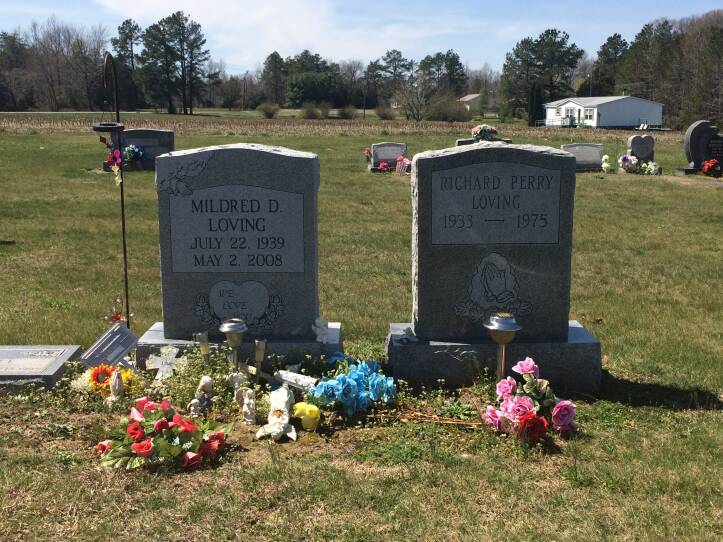This story is part one of a special three-part series on interracial marriage. It was produced in collaboration with the Schuster Institute for Investigative Journalism at Brandeis University.
Central Point, Va. — Not much has changed in the rural hamlet of Central Point, Virginia, since Richard Loving and Mildred Jeter, called “String Bean” for her slender frame, used to moon over one another in the 1950s. Teenagers still speed by the soybean fields where Richard raced his black Ford dragster. The couple's tumbledown white house still overlooks Passing Road, so named for residents of color who sometimes passed for white.
But one thing has changed. Richard and Mildred, the interracial couple who triggered the 1967 U.S. Supreme Court case that struck down state laws prohibiting interracial marriage, are long gone. Now, with the 50th anniversary of the landmark decision coming up June 12, their matching gravestones have become something of a tourist destination.
“Last weekend I saw a bride and groom visiting and taking pictures behind the tombstone,” said neighbor Glenda Rinaldi, who lives next door to the cemetery. “The bride was a black young lady, and the groom appeared to be white and Caucasian. I just thought that was awesome.”

Today, there are festivals and dances honoring interracial couples going on all over the country as the Lovings' court victory is widely regarded as a milestone in the country’s racial history. But ironically, here in Virginia, the Lovings' legacy has been embroiled in an escalating race-based conflict of its own. The question that has arisen is this: Was Mildred Loving actually black after all? And, more importantly, why is there a debate in the first place? That there is an argument about this at all 50 years later reflects the intensity of feelings about race in America today.
The dispute began more than a year ago when the Virginia Department of Historic Resources decided to erect a highway marker in honor of the Lovings in time for Monday's historic anniversary. But the writing of the text for the marker turned out to be hugely complicated.
The original text intended for the aluminum and metal marker, circulated publicly more than a year ago, described Richard and Mildred like this: “Richard Loving, a white man, and Mildred Jeter, a woman of African-American and Virginia Indian descent married in June 1958 in Washington D.C.”
But soon after those words were made public, Julie Langan, director of the Virginia Department of Historic Resources, got a call from Mark Loving, Mildred's grandson. He was not happy.
“He objected to our presenting any information that suggests that Mildred Loving was not Native-American, that she was African-American and not Native-American,” said Langan. “He would like her to be identified as all Virginia Indian.”
So, was Mildred Loving black, Native American, or both? The historic record on the subject is unclear. Mildred and her family are listed as Negro in the 1940 census. On her marriage license it just says “Indian.” And in a 1963 letter to the American Civil Liberties Union, Mildred identified herself as part Negro and part Indian. But nothing established her identity as black more firmly than the U.S. Supreme Court case that would make her name famous.
In his argument before the U.S. Supreme Court, the Loving’s lawyer, Philip Hirschkop, clearly traced the existence of laws banning interracial marriage back to slavery.
“You have before you today what we consider the most odious of the segregation laws and the slavery laws,” Hirschkop argued in 1967. “We hope to clearly show is that this is a slavery law ... These laws robbed the Negro race of their dignity. It's the worst part of these laws.”
If Mildred were not black at all — and no one can claim for sure what her heritage was — it wouldn't have kept the couple from being jailed after they married in Washington D.C. But some people think Mildred passed for black — just like some folks passed for white on Passing Road — only to strengthen her case before the Supreme Court. One of them is Arica L. Coleman author of a book about race and identity in Virginia, who has examined Mildred Loving's genealogy in detail.
“The Supreme Court would have had a hard time actually seeing this case beyond the paradigm of black and white,” said Coleman. “I believe that for the interest of this case, so that they could win this case and go on with their lives, that she acquiesced and just allowed herself to be Negro.”
That’s also what Mildred's grandson said in a television interview with Richmond station NBC12 last November when the Hollywood film about the Lovings was released nationwide. The movie portrayed Mildred as black and Richard as white.
“I know during those times there were only two colors, white and black, but she was Native-American. Both her parents were Native-American,” Loving said.
The puzzle of Mildred Loving's heritage is deeply rooted in Virginia's complex racial history. Decades earlier the state divided society into two categories, white and colored. Just one drop of African-American or Native-American blood meant a person was in the colored category.
Some Native-Americans started to reject any connection they had to black ancestry. In the 1990’s, the Rappahannock Indians, which Mildred claimed was her tribe, would not accept any members who had African-American blood, according to a local newspaper account.
Though Mildred self-identified as both black and Native-American earlier in her life, by the time Coleman interviewed her in 2004, she denied having any African-American roots. Coleman believes she was both.
“When I asked her about her Native-American heritage she was very open,” said Coleman. “Then I said, ‘Okay, can we talk about your black heritage?’ She immediately tensed up and said, ‘Oh, no. Oh, no. We have no black relatives.’”
Today, Mildred’s grandson, Mark, isn't the only one who says the same thing. Her brother Otha, and sister-in law, Ida, who also live on Passing Road, say she was pure Indian.
“I don't know who called her African-American, because she was an Indian as far as I know,” said Ida Jeter, at a family gathering at her home on a recent Sunday afternoon.
Hirshkop, who was just two months out of law school when he was brought on to the case, says Mildred clearly told him she was African-American, or Negro, which was the word used back then. So did several of her family members. Now, semi-retired at age 80, he says it didn’t matter to the case what race Mildred was.
“Legally, whether they were Native-American or African-American, the law was exactly the same, and the results of the law exactly the same,” he said. “It wouldn't have made any difference.”

All of this is a subject of discussion at the Sparta Fast Mart, a low-slung white market in Central Point where you can always get a loaf of bread and a pint of gossip. After Mark Loving's television appearance objecting to the portrayal of his grandmother in the recent Loving film, many folks got to talking about just what Mildred Loving was, or wasn't.
Ricky Crutchfield, pausing to fill up with gas on his way to go fishing on a recent afternoon, said he's just thankful he can marry the woman he loves. Crutchfield is black, and his fiancé is white.
“I love her, and I plan on marrying her next month,” said Crutchfield. “I do thank the Lovings very much and if they hear, tell them I very much thank you Mr. and Mrs. Loving, and I love y’all."
But others dropping by the store were clearly irked at the position that some members of the Loving family have taken. Shelia Morton, for one, said the family can't have it both ways.
“Back then when it was all about the law running them it was because she was being accepted in the black race, and he was in the white race,” said Morton. "Now, all of a sudden they ... want the kids or grandkids to say that they're Indian. What happened to the black part? It's a bunch of bull."
She added, “Now this is the last time I'ma tell you. They're blacks just like me.”
So where does all this leave the state's historic marker commemorating the case? Last year, the state of Virginia rewrote its highway marker to describe the Lovings simply as an interracial couple and removed all mention of her being either African-American or Native-American. But that didn't quell the controversy. Mark Loving and now a county supervisor continue to object, which the state's Julie Langan finds very disappointing.
“It is really disturbing and troubling to think that it is now 50 years later and we are still dealing with some of the same sensitivities that this marker is all about,” Langan said last week.
In the face of local opposition, the state last week moved the location of the highway marker away from a roadside several miles from the Lovings' gravesite. It's now to be near the former Virginia Court of Appeals in Richmond, where the Loving case was once heard, over an hour's drive away. Despite the controversy, Virginia Governor Terry McAuliffe is set on Monday to dedicate the marker, which has been in storage for over a year.
This series was produced by Josh Swartz. To hear part two of the series, click here . For part three, click here .
Editor’s Note: Arica L. Coleman, who is featured in this story, submitted a comment accusing the reporter of not properly crediting her scholarly work on Mildred Loving. WGBH News takes questions of journalistic integrity seriously and we have spoken with Coleman about her concerns. We find her claim to be without merit and stand by the story.
We thank Coleman for lending her expertise to this story. She was one of many sources the reporter consulted.
On the advice of legal counsel, we have removed the comments because they contained defamatory statements.




